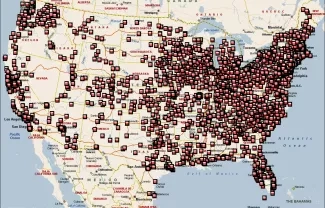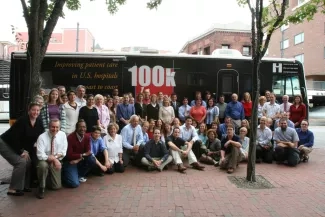Why It Matters

About three-quarters of all hospitals in the United States enrolled in the 100,000 Lives Campaign.
It’s been ten years since the end of the 100,000 Lives Campaign.
The Campaign was one of the things that put IHI — and our commitment to patient safety — on the map, and so we at IHI are taking a moment to reflect on the anniversary and the work that remains.
The Campaign started at the IHI National Forum in December 2004, when Don Berwick announced a bold new initiative. We would work together with willing hospitals to reduce needless deaths by 100,000 over 18 months. A phrase borrowed from political campaigns became our cri de coeur: “Some is not a number. Soon is not a time.” We set June 14, 2006, as our deadline.

Dr. Don Berwick announces the launch of the 100,000 Lives Campaign at the IHI National Forum.
That’s how it started, with the ambitious idea that we could find ways to save 100,000 lives, and we could provide support for hospitals that wanted to deliberately improve patient safety. We set a low bar for participation in order to create a groundswell of effort. Over 18 months, IHI provided expert guidance, materials, and support at no cost. We held webinars, office hours, and published Getting Started Kits and How-to Guides for the Campaign’s six key interventions:
- Rapid Response Teams
- Improved Care for Acute Myocardial Infarction
- Medication Reconciliation
- Preventing Central Line Infections
- Preventing Surgical Site Infections
- Preventing Ventilator-Associated Pneumonia
In addition to the lives saved goal, the team had three aims: enroll more than 2,000 hospitals in the initiative; build a reusable national infrastructure for change; and raise the profile of the problem. We were careful to acknowledge that we could not show a causal relationship between the decrease in mortality and what hospitals did as part of the Campaign — and the lives saved calculation was complicated — but with the help of many partners and engaged, enthusiastic improvers, we spurred a lot of action and generated a lot of interest and discussion.
In the end, about 3,100 hospitals enrolled in the Campaign — about three-quarters of all hospitals in the United States at the time. With the help of QIOs, hospitals associations, and others, we built a national infrastructure for change, with a “node” in every state (a coalition of organizations to support change locally), a network of 155 “mentor hospitals” that had success on the Campaign interventions and offered to help others, and facilitated affinity groups, such as rural hospitals and academic medical centers, which came together to share ideas and best practices.

The Campaign Field Team traveled the country visiting participating hospitals.
And we were able to raise the profile of the problem. One indicator we tracked was IHI media impressions, which rose to 250 million in the final year of the Campaign. Our shrink-wrapped RV literally brought the Campaign to the streets, and the Campaign Field Team received a warm welcome at each stop along the way. Campaign Manager Joe McCannon was even on CNN to discuss the results of the Campaign.
And on June 14, 2006, we celebrated more than 122,000 fewer needless deaths over the 18-month Campaign period.

The Campaign’s impact rippled across the organization and the world. Some of the lasting impacts:
- IHI followed with the 5 Million Lives Campaign – a campaign to avoid 5 million instances of harm.
- Related campaigns were launched in Canada, Australia, Sweden, Denmark, UK, Japan, and elsewhere.
- WIHI, IHI’s free audio program, was born out of Campaign Live!
- How-to Guides are now a standard format for IHI.
- The national field structure developed during the Campaign informs IHI’s work with The Conversation Project.
- Don Berwick and Joe McCannon brought lessons from leading the Campaigns to CMS and the Partnership for Patients.
- The Scottish Patient Safety Programme, which was linked to 20,000 deaths avoided, followed suit.
- In Denmark, a patient safety program led to reduction in mortality as well.
The initial impact of100,000 Lives Campaign was enormous, and many of those interventions are still in place in many parts of the world. IHI’s work in Qatar, for example, is based on the interventions from 100,000 Lives.
At the same time, we’re thinking about what’s next in patient safety. As recent media coverage demonstrated, there’s still a lot of harm. People are still dying in our hospitals needlessly. We won’t rest until that is no longer the case. We remain committed to finding new ways to support individuals and organizations working hard to improve patient safety, including settings all along the continuum of care – from patients’ homes, to primary care practices, hospitals, post-acute settings, and long-term care facilities.
This morning, Campaign Manager Joe McCannon, who has since started his own venture, sent an email to everyone at IHI who worked on the Campaign, some of us still at IHI, others who have moved on to other important work. His email and the flurry of replies were a chorus of appreciation, with each individual noting their involvement with the Campaign as a professional highlight.
The spirit and dedication of the thousands of individuals who contributed to the success of the Campaign and who continue to do the hard work to improve patient care is remarkable. That is something to reflect on and to celebrate.
Joelle Baehrend, MA, is an IHI Senior Project Director.
You may also be interested in:
10 IHI Innovations to Improve Health and Health Care
Berwick Looks Back: IHI Ideas and Innovations
You may also be interested in:
